The Economics and Statistics Division maintains archives of previous publications for accountability purposes, but makes no updates to keep these documents current with the latest data revisions from Statistics Canada. As a result, information in older documents may not be accurate. Please exercise caution when referring to older documents. For the latest information and historical data, please contact the individual listed to the right.
<--- Return to Archive
For additional information relating to this article, please contact:
August 26, 2020BUSINESS OPENING AND CLOSING, MAY 2020 Statistics Canada is releasing data on monthly business openings and closures for the period 2015 through May 2020. A study details the methodology behind these measures. Business openings and closures differ in concept from business entry and exits. A business will be classified as open if had no employment in the previous month and then has employment in the next month and a business will be closed if it had employment the previous month and no employment in the current month. For opening and closing, the reason could be a permanent change (i.e. business exit) or temporary for reasons such as seasonal operations, capital maintenance, restructuring or the COVID-19 situation. Continuing business are those that had employment in both the current and previous month. Active businesses are the sum of continuing and opening business in the current month.
The number of active business in Canada and Nova Scotia had been trending upwards from 2015 through 2019. The average number of active business in Nova Scotia in 2019 was 1.4 per cent larger than in 2015; Canada increased 2.2 per cent. The number of active business has declined sharply in March through May 2020 in all provinces.
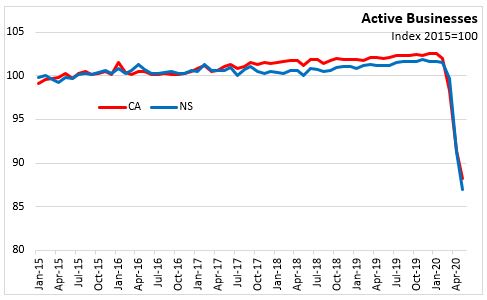
The number of active business continued to decline in all provinces in May from April 2020.
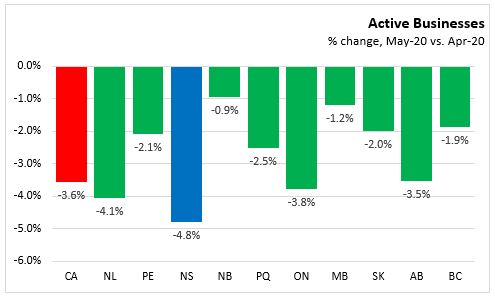
Compared to May 2019, the number of active business in all provinces was lower in May 2020. Nova Scotia had 14.0 per cent fewer active businesses and nationally there were 13.5 per cent fewer. Nova Scotia had 17,462 active business in May 2019 and 15,018 in May 2020 - a decrease of 2,444 active businesses. Ontario (-15.4%) reported the largest decline and Manitoba (-7.0%) the smallest compared to last year.
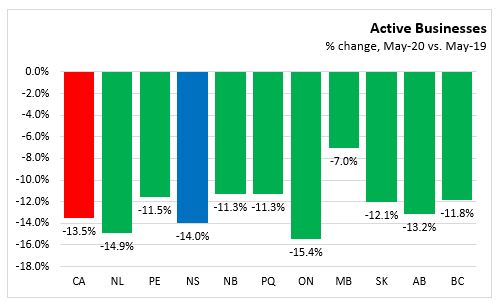
The calculation for the opening, continuing and closure rate have been made based on the number of active business in the previous month. The rate at which business either opened, continued or closed can be examined see how number of active business has changed. The business opening rate for Nova Scotia was 3.5 per cent in May 2020 down from 4.8 per cent in May 2019. British Columbia is the only province with a higher opening rate in May 2020 and Manitoba's opening rate was little changed. The opening rate change is more modest compared to the change from closures.
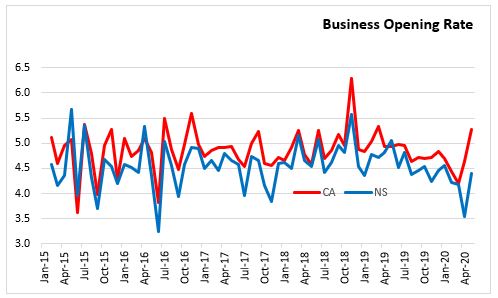
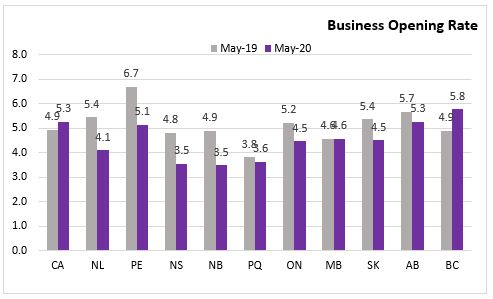
Most businesses continue operating each month and Nova Scotia and Canada have had similar business continuing rates over the 2015 and 2019 period of around 95 per cent. The business continuing rate began to decline in March 2020 and fell to historically low levels amid the COVID-19 pandemic in April 2020 but is up in May for Nova Scotia and Canada . The continuing rate was 91.2 per cent in Nova Scotia and 91.1 per cent in Canada in May 2020. Continuing rates were lower in May 2020 than May 2019 for all provinces.
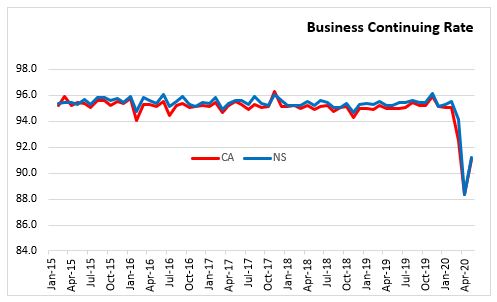

Business closures, including temporary closures, decreased in May 2020 compared to April 2019. For Nova Scotia, there were 790 business closures in February 2020 and increased to 1,997 business closed in April 2020 and has fallen to 1,394 closed in May 2020. The business closure rate in Nova Scotia and Canada have followed similar trend since 2015 including through May 2020. Closure rate continued to be elevated in May 2020 compared to May 2019.
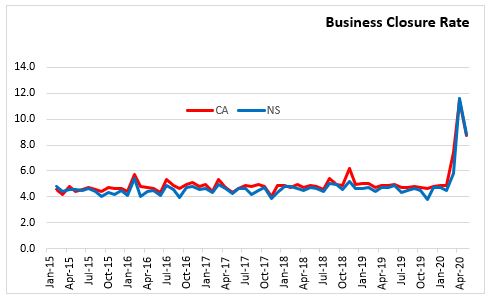
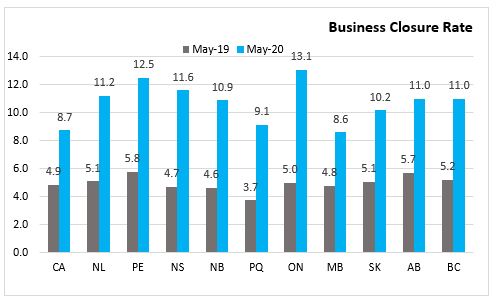
The COVID-19 situation has impacted sectors to different degrees. Nova Scotia active business are lower in all sectors in May 2020 compared to last year. Canada had lower active business in all sectors compared to May2019. Nova Scotia largest declines have been in accommodation and food services (-28.5%) and arts, entertainment and recreation (-27.1%), and other services (-19.7%).
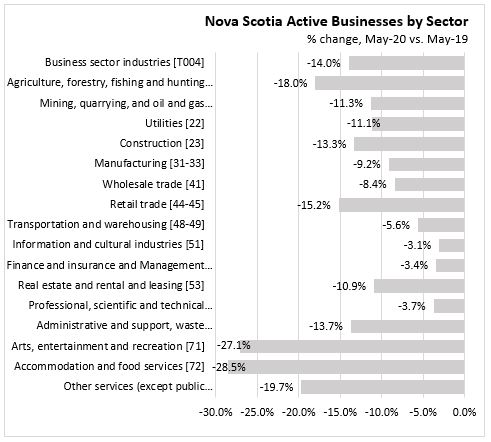
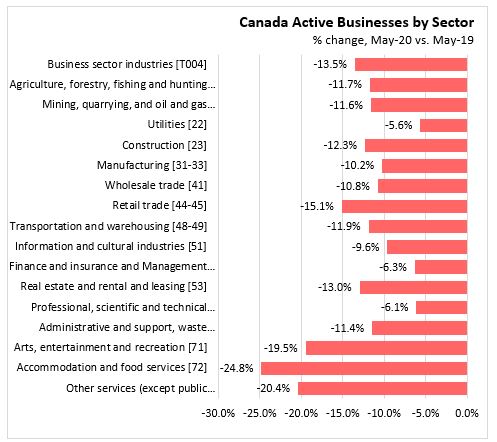
There are some noticeable declines in the number of active business in recent months. Compared to February 2020, among goods-producing sector, the fewer active business in Nova Scotia have mostly been in agriculture, forestry, fishing and mining, construction, and manufacturing.
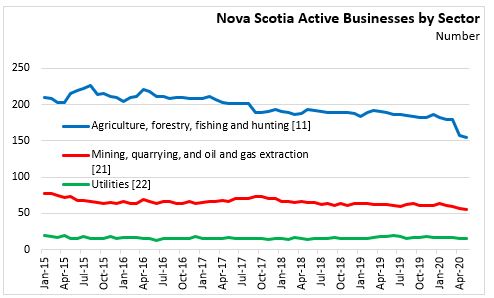

Among service-producing industries, some of the largest declines have been in the sectors with the most businesses. Retail trade, accommodation and food services, and other services have reported the largest declines in number of active businesses compared to February 2020.

Wholesale, transportation, real estate and rentals businesses, and administrative and support services all have notable declines in the recent months impacted by COVID-19.
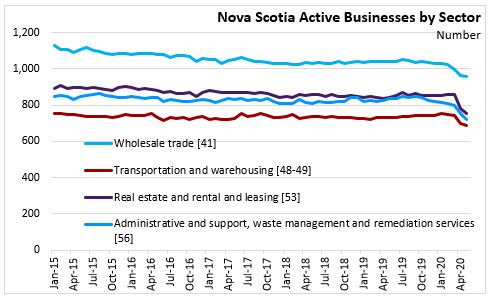
The number of active business in information and cultural industries and finance and insurance are little changed from historical levels in May 2020.
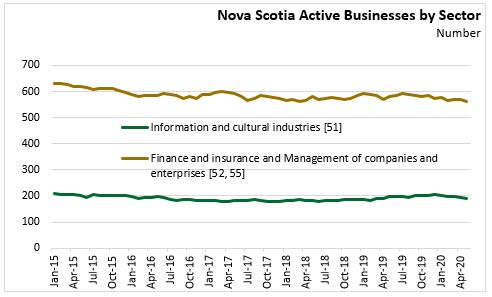
All Census Metropolitan areas (CMAs) reported fewer active business in May 2020 compared to the previous year. Halifax reported 12.3 per cent fewer active business, a smaller decline than the Nova Scotia (-14.0%). The largest decline among the CMAs was in Windsor (-18.3%) and the smallest was in Abbotsford-Mission (-7.1%).
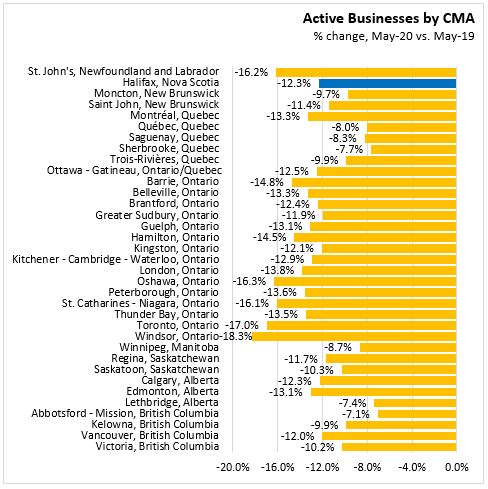
The source data is seasonally adjusted. The data may not aggregate due to firms being classified into multiple industry or geography.
Source: Statistics Canada. Table 33-10-0270-01 Experimental estimates for business openings and closures for Canada, provinces and territories, census metropolitan areas
<--- Return to Archive